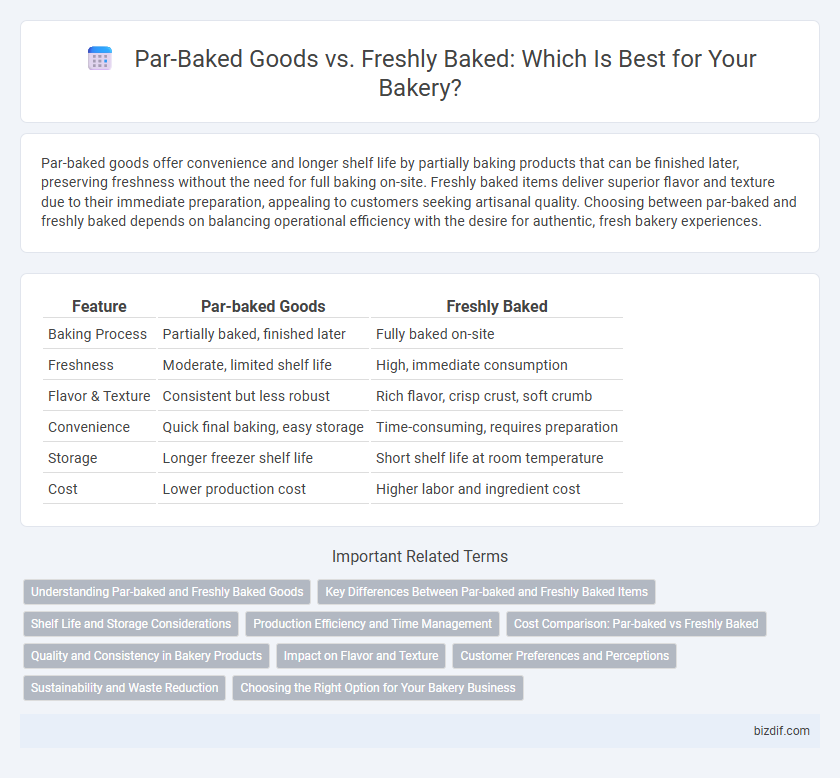Par-baked goods offer convenience and longer shelf life by partially baking products that can be finished later, preserving freshness without the need for full baking on-site. Freshly baked items deliver superior flavor and texture due to their immediate preparation, appealing to customers seeking artisanal quality. Choosing between par-baked and freshly baked depends on balancing operational efficiency with the desire for authentic, fresh bakery experiences.
Table of Comparison
| Feature | Par-baked Goods | Freshly Baked |
|---|---|---|
| Baking Process | Partially baked, finished later | Fully baked on-site |
| Freshness | Moderate, limited shelf life | High, immediate consumption |
| Flavor & Texture | Consistent but less robust | Rich flavor, crisp crust, soft crumb |
| Convenience | Quick final baking, easy storage | Time-consuming, requires preparation |
| Storage | Longer freezer shelf life | Short shelf life at room temperature |
| Cost | Lower production cost | Higher labor and ingredient cost |
Understanding Par-baked and Freshly Baked Goods
Par-baked goods are partially baked products designed to be finished baking later, offering extended shelf life and quick preparation for retailers. Freshly baked goods are fully baked on-site, providing superior flavor and texture due to the immediate freshness and no preservation methods. Understanding these differences helps bakeries balance convenience, quality, and customer preferences effectively.
Key Differences Between Par-baked and Freshly Baked Items
Par-baked goods undergo partial baking and are frozen or chilled for later finishing, offering longer shelf life and quick preparation, while freshly baked items are fully baked and served immediately for optimal flavor and texture. The key differences include freshness, with freshly baked products providing superior taste and aroma, compared to par-baked items that balance convenience and quality. Storage requirements also vary, as par-baked goods demand freezing, whereas freshly baked goods require prompt consumption to maintain peak quality.
Shelf Life and Storage Considerations
Par-baked goods offer an extended shelf life due to their partially baked state, allowing for freezing and longer storage without significant quality loss, making them ideal for on-demand finishing. Freshly baked products provide superior flavor and texture but require prompt consumption or refrigeration to maintain freshness, typically lasting only one to two days at room temperature. Proper storage for par-baked items involves freezing or refrigeration, while freshly baked goods benefit from airtight containers and cool, dry environments to prevent staleness.
Production Efficiency and Time Management
Par-baked goods enhance production efficiency by allowing partial baking ahead of time, reducing on-site baking duration and enabling quick finalization during peak hours. This method optimizes time management by minimizing wait times for customers while maintaining consistent product quality. Freshly baked items require longer preparation, making par-baked options ideal for high-demand environments seeking rapid service without sacrificing freshness.
Cost Comparison: Par-baked vs Freshly Baked
Par-baked goods typically have lower labor and time costs compared to freshly baked items, as they are partially baked and finished on-site, reducing overall preparation time. Freshly baked goods require more skilled labor, longer baking times, and higher energy consumption, increasing production expenses. The initial investment in par-baked inventory may be higher, but operational efficiencies often lead to lower long-term costs versus fresh baking from raw dough.
Quality and Consistency in Bakery Products
Par-baked goods offer consistent texture and flavor by undergoing partial baking and freezing, ensuring uniform quality across batches. Freshly baked products provide superior aroma and peak freshness, often delivering a richer sensory experience but with greater variability in quality. Balancing par-baked and freshly baked options allows bakeries to optimize shelf life while maintaining high standards of taste and texture.
Impact on Flavor and Texture
Par-baked goods retain consistent texture and flavor by undergoing a partial bake, then finishing the baking process before consumption, which preserves moisture but may result in a slightly less fresh crust compared to fully freshly baked products. Freshly baked goods offer superior flavor complexity and a crisp, well-developed crust due to the complete baking process occurring just prior to serving. The choice between par-baked and freshly baked directly affects consumer experience, with freshly baked items typically delivering a richer aroma and more satisfying texture.
Customer Preferences and Perceptions
Customers often perceive freshly baked goods as superior in taste, texture, and aroma due to their just-out-of-oven appeal, reinforcing a preference for authenticity and quality. Par-baked goods offer convenience and longer shelf life but sometimes face skepticism regarding freshness and flavor authenticity. Consumer preference trends indicate a growing demand for artisanal and freshly made bakery items, driven by increased awareness of ingredient quality and baking processes.
Sustainability and Waste Reduction
Par-baked goods require less energy during the final baking process, significantly reducing overall carbon emissions compared to freshly baked products. These partially baked items extend shelf life, minimizing food waste by allowing bakeries and retailers to bake only what is needed on demand. This approach supports sustainable practices by optimizing resource use and decreasing unsold inventory that typically contributes to landfill waste.
Choosing the Right Option for Your Bakery Business
Par-baked goods offer significant time savings and consistency, allowing bakeries to quickly finish and serve fresh-tasting products while reducing labor costs. Freshly baked items provide superior flavor, texture, and customer appeal, enhancing the bakery's brand reputation and encouraging repeat business. Selecting the right option depends on balancing operational efficiency with quality expectations to meet target market demands and optimize profitability.
Par-baked Goods vs Freshly Baked Infographic

 bizdif.com
bizdif.com